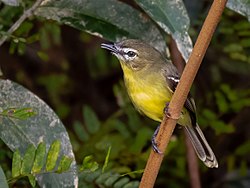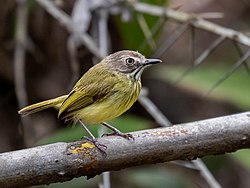| Image | Genus | Species |
|---|
 | Piprites Cabanis, 1847 | |
 | Phyllomyias Cabanis & Heine, 1859 | |
 | Acrochordopus Berlepsch & Hellmayr, 1905 | |
 | Tyranniscus Cabanis & Heine, 1860 | |
 | Tyrannulus Vieillot, 1816 | |
 | Myiopagis Salvin & Godman, 1888 | |
 | Elaenia Sundevall, 1836 | - Yellow-bellied elaenia, Elaenia flavogaster
- Caribbean elaenia, Elaenia martinica
- Large elaenia, Elaenia spectabilis
- Noronha elaenia, Elaenia ridleyana
- White-crested elaenia, Elaenia albiceps
- Chilean elaenia, Elaenia chilensis
- Small-billed elaenia, Elaenia parvirostris
- Olivaceous elaenia, Elaenia mesoleuca
- Slaty elaenia, Elaenia strepera
- Mottle-backed elaenia, Elaenia gigas
- Brownish elaenia, Elaenia pelzelni
- Plain-crested elaenia, Elaenia cristata
- Lesser elaenia, Elaenia chiriquensis
- Coopmans's elaenia, Elaenia brachyptera
- Rufous-crowned elaenia, Elaenia ruficeps
- Mountain elaenia, Elaenia frantzii
- Highland elaenia, Elaenia obscura
- Small-headed elaenia, Elaenia sordida
- Great elaenia, Elaenia dayi
- Sierran elaenia, Elaenia pallatangae
- Tepui elaenia, Elaenia olivina
- Greater Antillean elaenia, Elaenia fallax
|
 | Ornithion Hartlaub, 1853 | |
 | Camptostoma P.L. Sclater, 1857 | |
 | Suiriri d'Orbigny, 1840 | |
 | Mecocerculus P.L. Sclater, 1862 | |
 | Anairetes Reichenbach, 1850 | |
 | Uromyias Hellmayr, 1927 | |
 | Serpophaga Gould, 1839 | |
 | Nesotriccus Townsend, CH, 1895 | |
 | Capsiempis Cabanis & Heine, 1859 | |
 | Polystictus Reichenbach, 1850 | |
 | Pseudocolopteryx Lillo, 1905 | |
 | Pseudotriccus Taczanowski & Berlepsch, 1885 | |
 | Corythopis Sundevall, 1836 | |
 | Euscarthmus Wied-Neuwied, 1831 | |
 | Pseudelaenia W. Lanyon, 1988 | |
 | Stigmatura Sclater & Salvin, 1866 | |
 | Zimmerius Traylor, 1977 | - Guatemalan tyrannulet, Zimmerius vilissimus
- Mistletoe tyrannulet, Zimmerius parvus
- Spectacled tyrannulet, Zimmerius improbus
- Venezuelan tyrannulet, Zimmerius petersi
- Bolivian tyrannulet, Zimmerius bolivianus
- Red-billed tyrannulet, Zimmerius cinereicapilla
- Mishana tyrannulet, Zimmerius villarejoi
- Chico's tyrannulet, Zimmerius chicomendesi
- Slender-footed tyrannulet, Zimmerius gracilipes
- Guianan tyrannulet, Zimmerius acer
- Golden-faced tyrannulet Zimmerius chrysops
- Coopmans's tyrannulet, Zimmerius minimus
- Choco tyrannulet, Zimmerius albigularis
- Loja tyrannulet, Zimmerius flavidifrons
- Peruvian tyrannulet, Zimmerius viridiflavus
|
 | Pogonotriccus Cabanis & Heine, 1859 | |
 | Phylloscartes Cabanis & Heine, 1859 | - Mottle-cheeked tyrannulet, Phylloscartes ventralis
- Alagoas tyrannulet, Phylloscartes ceciliae
- Restinga tyrannulet, Phylloscartes kronei
- Bahia tyrannulet, Phylloscartes beckeri
- Panama tyrannulet, Phylloscartes flavovirens
- Olive-green tyrannulet, Phylloscartes virescens
- Ecuadorian tyrannulet, Phylloscartes gualaquizae
- Black-fronted tyrannulet, Phylloscartes nigrifrons
- Rufous-browed tyrannulet, Phylloscartes superciliaris
- Rufous-lored tyrannulet, Phylloscartes flaviventris
- Cinnamon-faced tyrannulet, Phylloscartes parkeri
- Minas Gerais tyrannulet, Phylloscartes roquettei
- Oustalet's tyrannulet, Phylloscartes oustaleti
- Bay-ringed tyrannulet, Phylloscartes sylviolus
|
 | Mionectes Cabanis, 1844 | |
 | Leptopogon Cabanis, 1844 | |
 | Guyramemua Lopes et al., 2017 | |
 | Sublegatus Sclater & Salvin, 1868 | |
 | Inezia Cherrie, 1909 | |
 | Myiophobus Reichenbach, 1850 | |
 | Nephelomyias (Ohlson, Fjeldsa and Ericson, 2009) | |
 | Myiotriccus Ridgway, 1905 | |
 | Tachuris Lafresnaye, 1836 | |
 | Culicivora Swainson, 1827 | |
 | Hemitriccus Cabanis & Heine, 1859 | - Snethlage's tody-tyrant, Hemitriccus minor
- Boat-billed tody-tyrant, Hemitriccus josephinae
- Flammulated bamboo tyrant, Hemitriccus flammulatus
- Drab-breasted bamboo tyrant, Hemitriccus diops
- Brown-breasted bamboo tyrant, Hemitriccus obsoletus
- White-eyed tody-tyrant, Hemitriccus zosterops
- Zimmer's tody-tyrant, Hemitriccus minimus
- Eye-ringed tody-tyrant, Hemitriccus orbitatus
- Johannes's tody-tyrant, Hemitriccus iohannis
- Stripe-necked tody-tyrant, Hemitriccus striaticollis
- Hangnest tody-tyrant, Hemitriccus nidipendulus
- Yungas tody-tyrant, Hemitriccus spodiops
- Pearly-vented tody-tyrant, Hemitriccus margaritaceiventer
- Pelzeln's tody-tyrant, Hemitriccus inornatus
- Black-throated tody-tyrant, Hemitriccus granadensis
- Buff-throated tody-tyrant, Hemitriccus rufigularis
- Cinnamon-breasted tody-tyrant, Hemitriccus cinnamomeipectus
- Buff-breasted tody-tyrant, Hemitriccus mirandae
- Kaempfer's tody-tyrant, Hemitriccus kaempferi
- Fork-tailed tody-tyrant, Hemitriccus furcatus
- White-bellied tody-tyrant, Hemitriccus griseipectus
- Acre tody-tyrant, Hemitriccus cohnhafti
|
 | Myiornis Bertoni, A.W., 1901 | |
 | Oncostoma P.L. Sclater, 1862 | |
 | Lophotriccus Berlepsch, 1884 | |
 | Atalotriccus Ridgway, 1905 | |
 | Poecilotriccus Berlepsch, 1884 | - Rufous-crowned tody-flycatcher, Poecilotriccus ruficeps
- Lulu's tody-flycatcher, Poecilotriccus luluae
- White-cheeked tody-flycatcher, Poecilotriccus albifacies
- Black-and-white tody-flycatcher, Poecilotriccus capitalis
- Buff-cheeked tody-flycatcher, Poecilotriccus senex
- Ruddy tody-flycatcher, Poecilotriccus russatus
- Ochre-faced tody-flycatcher, Poecilotriccus plumbeiceps
- Smoky-fronted tody-flycatcher, Poecilotriccus fumifrons
- Rusty-fronted tody-flycatcher, Poecilotriccus latirostris
- Slaty-headed tody-flycatcher, Poecilotriccus sylvia
- Golden-winged tody-flycatcher, Poecilotriccus calopterus
- Black-backed tody-flycatcher, Poecilotriccus pulchellus
|
 | Taeniotriccus Berlepsch & Hartert, 1902 | |
 | Todirostrum – typical tody-flycatchers Lesson, 1831 | |
 | Cnipodectes P.L. Sclater & Salvin, 1873 | |
 | Rhynchocyclus Cabanis & Heine, 1859 | |
 | Tolmomyias Hellmayr, 1927 | |
 | Calyptura Swainson, 1832 | |
 | Platyrinchus Desmarest, 1805 | |
 | Neopipo Sclater & Salvin, 1869 | |
 | Pyrrhomyias Cabanis & Heine, 1859 | |
 | Hirundinea Orbigny & Lafresnaye, 1837 | |
 | Lathrotriccus Lanyon, W & Lanyon, S, 1986 | |
 | Aphanotriccus Ridgway, 1905 | |
 | Cnemotriccus Hellmayr, 1927 | |
 | Xenotriccus Dwight & Griscom, 1927 | |
 | Sayornis – phoebes Bonaparte, 1854 | |
 | Mitrephanes Coues, 1882 | |
 | Contopus Cabanis, 1855 | - Olive-sided flycatcher, Contopus cooperi
- Greater pewee, Contopus pertinax
- Dark pewee, Contopus lugubris
- Smoke-colored pewee, Contopus fumigatus
- Ochraceous pewee, Contopus ochraceus
- Western wood pewee, Contopus sordidulus
- Eastern wood pewee, Contopus virens
- Northern tropical pewee, Contopus bogotensis
- Southern tropical pewee, Contopus cinereus
- Tumbes pewee, Contopus punensis
- White-throated pewee, Contopus albogularis
- Blackish pewee, Contopus nigrescens
- Cuban pewee, Contopus caribaeus
- Hispaniolan pewee, Contopus hispaniolensis
- Jamaican pewee, Contopus pallidus
- Lesser Antillean pewee, Contopus latirostris
|
 | Empidonax Cabanis, 1855 | - Yellow-bellied flycatcher, Empidonax flaviventris
- Acadian flycatcher, Empidonax virescens
- Alder flycatcher, Empidonax alnorum
- Willow flycatcher, Empidonax traillii
- White-throated flycatcher, Empidonax albigularis
- Least flycatcher, Empidonax minimus
- Hammond's flycatcher, Empidonax hammondii
- American grey flycatcher, Empidonax wrightii
- American dusky flycatcher, Empidonax oberholseri
- Pine flycatcher, Empidonax affinis
- Western flycatcher, Empidonax difficilis
- Yellowish flycatcher, Empidonax flavescens
- Buff-breasted flycatcher, Empidonax fulvifrons
- Black-capped flycatcher, Empidonax atriceps
|
 | Pyrocephalus Gould, 1839 | |
 | Ochthornis P.L. Sclater, 1888 | |
 | Satrapa Strickland, 1844 | |
 | Syrtidicola Chesser et al, 2020 | |
 | Muscisaxicola – ground tyrants Orbigny & Lafresnaye, 1837 | - Spot-billed ground tyrant, Muscisaxicola maculirostris
- White-fronted ground tyrant, Muscisaxicola albifrons
- Ochre-naped ground tyrant, Muscisaxicola flavinucha
- Paramo ground tyrant, Muscisaxicola alpinus
- Taczanowski's ground tyrant, Muscisaxicola griseus
- Cinereous ground tyrant, Muscisaxicola cinereus
- Rufous-naped ground tyrant, Muscisaxicola rufivertex
- Dark-faced ground tyrant, Muscisaxicola maclovianus
- White-browed ground tyrant, Muscisaxicola albilora
- Cinnamon-bellied ground tyrant, Muscisaxicola capistratus
- Puna ground tyrant, Muscisaxicola juninensis
- Black-fronted ground tyrant, Muscisaxicola frontalis
|
 | Lessonia Swainson, 1832 | |
 | Hymenops Lesson, 1828 | |
 | Knipolegus F. Boie, 1826 | - Blue-billed black tyrant, Knipolegus cyanirostris
- Jelski's black tyrant, Knipolegus signatus
- Plumbeous tyrant, Knipolegus cabanisi
- Cinereous tyrant, Knipolegus striaticeps
- White-winged black tyrant, Knipolegus aterrimus
- Hudson's black tyrant, Knipolegus hudsoni
- Rufous-tailed tyrant, Knipolegus poecilurus
- Riverside tyrant, Knipolegus orenocensis
- Amazonian black tyrant, Knipolegus poecilocercus
- Crested black tyrant, Knipolegus lophotes
- Velvety black tyrant, Knipolegus nigerrimus
- Sao Francisco black tyrant or Caatinga black tyrant, Knipolegus franciscanus
|
 | Cnemarchus Ridgway, 1905 | |
 | Xolmis F. Boie, 1826 | |
 | Pyrope Cabanis & Heine, 1860 | |
 | Nengetus Swainson, 1827 | |
 | Neoxolmis Hellmayr, 1927 | |
 | Myiotheretes Reichenbach, 1850 | |
 | Agriornis – shrike-tyrants Gould, 1839 | |
 | Gubernetes Such, 1825 | |
 | Muscipipra Lesson, 1831 | |
 | Fluvicola Swainson, 1827 | |
 | Arundinicola d'Orbigny, 1840 | |
 | Heteroxolmis Lanyon, W, 1986 | |
 | Alectrurus Vieillot, 1816 | |
 | Silvicultrix Lanyon, W, 1986 | |
 | Ochthoeca Cabanis, 1847 | - Tumbes tyrant, Ochthoeca salvini
- Slaty-backed chat-tyrant, Ochthoeca cinnamomeiventris
- Blackish chat-tyrant, Ochthoeca nigrita
- Maroon-belted chat-tyrant, Ochthoeca thoracica
- Rufous-breasted chat-tyrant, Ochthoeca rufipectoralis
- Brown-backed chat-tyrant, Ochthoeca fumicolor
- Rufous-browed chat-tyrant, Ochthoeca superciliosa
- D'Orbigny's chat-tyrant, Ochthoeca oenanthoides
- White-browed chat-tyrant, Ochthoeca leucophrys
- Piura chat-tyrant, Ochthoeca piurae
|
 | Colorhamphus Sundevall, 1872 | |
 | Colonia | |
 | Muscigralla Orbigny & Lafresnaye, 1837 | |
 | Machetornis G.R. Gray, 1841 | |
 | Legatus P.L. Sclater, 1859 | |
 | Phelpsia W. Lanyon, 1984 | |
 | Myiozetetes P.L. Sclater, 1859 | |
 | Pitangus Swainson, 1827 | |
 | Philohydor Lanyon, W, 1984 | |
 | Conopias Cabanis & Heine, 1859 | |
 | Myiodynastes Bonaparte, 1857 | |
 | Megarynchus Thunberg, 1824 | |
 | Tyrannopsis Ridgway, 1905 | |
 | Empidonomus Cabanis & Heine, 1859 | |
 | Tyrannus Lacépède, 1799 | - Snowy-throated kingbird, Tyrannus niveigularis
- White-throated kingbird, Tyrannus albogularis
- Tropical kingbird, Tyrannus melancholicus
- Couch's kingbird, Tyrannus couchii
- Cassin's kingbird, Tyrannus vociferans
- Thick-billed kingbird, Tyrannus crassirostris
- Western kingbird, Tyrannus verticalis
- Scissor-tailed flycatcher, Tyrannus forficatus
- Fork-tailed flycatcher, Tyrannus savana
- Eastern kingbird, Tyrannus tyrannus
- Gray kingbird, Tyrannus dominicensis
- Giant kingbird, Tyrannus cubensis
- Loggerhead kingbird, Tyrannus caudifasciatus
|
 | Rhytipterna Reichenbach, 1850 | |
 | Sirystes Cabanis & Heine, 1859 | |
 | Casiornis Des Murs, 1856 | |
 | Myiarchus Cabanis, 1844 | - Rufous flycatcher, Myiarchus semirufus
- Yucatan flycatcher, Myiarchus yucatanensis
- Sad flycatcher, Myiarchus barbirostris
- Dusky-capped flycatcher, Myiarchus tuberculifer
- Swainson's flycatcher, Myiarchus swainsoni
- Venezuelan flycatcher, Myiarchus venezuelensis
- Panama flycatcher, Myiarchus panamensis
- Short-crested flycatcher, Myiarchus ferox
- Pale-edged flycatcher, Myiarchus cephalotes
- Sooty-crowned flycatcher, Myiarchus phaeocephalus
- Apical flycatcher, Myiarchus apicalis
- Ash-throated flycatcher, Myiarchus cinerascens
- Nutting's flycatcher, Myiarchus nuttingi
- Great crested flycatcher, Myiarchus crinitus
- Brown-crested flycatcher, Myiarchus tyrannulus
- Grenada flycatcher, Myiarchus nugator
- Galapagos flycatcher, Myiarchus magnirostris
- Rufous-tailed flycatcher, Myiarchus validus
- La Sagra's flycatcher, Myiarchus sagrae
- Stolid flycatcher, Myiarchus stolidus
- Lesser Antillean flycatcher, Myiarchus oberi
- Puerto Rican flycatcher, Myiarchus antillarum
|
 | Ramphotrigon G.R. Gray, 1855 | |
 | Attila Lesson, 1831 | |
|










































































































